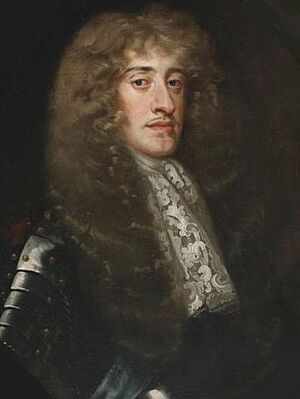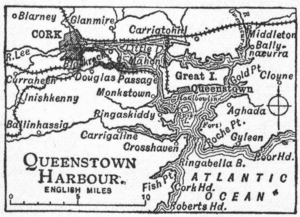James Fitz Edmond Cotter facts for kids
Quick facts for kids
James Fitz Edmond Cotter
|
|
|---|---|
| Born | c. 1630 Anngrove, County Cork, Ireland |
| Died | 1705 Anngrove |
| Buried |
Carrigtwohill, County Cork, Ireland.
|
| Allegiance | Royalist, Jacobite |
| Rank | Brigadier General |
| Commands held | A company of infantry and later a regiment of cavalry. Governor of Montserrat. Governor of the City of Cork. Commander of the military forces of a number of Irish counties. |
| Battles/wars | English Civil War, Battle of Worcester, Battle of Sedgemoor, Williamite War in Ireland |
| Awards | Knighthood |
Sir James Fitz Edmond Cotter (Irish: Séamus Buidhe Mac Coitir or Séamus Mac Éamonn Mhic Coitir; born around 1630–died 1705) was an important soldier and leader in Ireland. He also served as a governor in a colony far away. He was the main commander for King James's army in several Irish counties, including Cork, Limerick, Tipperary, and Kerry.
Sir James was a well-known person in the south of Ireland. He supported the Royalists (who backed the King) and later the Jacobites (who supported King James II after he lost his throne). He was part of the Irish Cotter family, who had Norse-Gaelic roots. He was born in Anngrove, County Cork, and became a knight between 1685 and 1686. He passed away in 1705.
Contents
Sir James Cotter's Career
Working for the King
James Cotter began his career by supporting the King during the English Civil War. Family stories say he fought for King Charles II at the Battle of Worcester in 1651. When King Charles II returned to the throne in 1660, James Cotter was a lieutenant in an infantry (foot soldier) regiment.
He became known for carrying out a special mission for the King. Some people who had gone against the previous king, Charles I, had fled the country. James Cotter was part of a group that tracked down one of these people, John Lisle, in Switzerland in 1664. They were acting under official orders from the King. James Cotter and his friends, Miles Crowley and John Rierdan, were rewarded by the English Crown for their actions.
Service in the Colonies
After this mission, James Cotter was promoted to captain. In 1666, he went to the West Indies, leading a company of soldiers. In 1667, he led 700 men in an attack on the island of St Christopher, but he was captured by the French.
Later, in 1680, he was promoted to colonel. He became the Deputy-Governor of the island of Montserrat and then its Governor in 1681. From his royal pension and the money he earned as governor, James Cotter became very rich. He used his wealth to buy more land in the Cork area of Ireland.
Supporting King James II
It is believed that James Cotter was close to King James II. He might have even served with the King at sea when James was the Duke of York and an admiral. King James reportedly called Cotter "Shaymus Bwee," which is Séamus Buidhe in Irish.
In 1685, James Cotter was a Lieutenant Colonel. He is thought to have been made a knight by King James after the Battle of Sedgemoor in 1685. Official records show him as a knight starting in 1686.
King James II became a Roman Catholic before he became king. When he had a son who would also be raised Catholic, it led to the Glorious Revolution of 1688. King James fled England, and his Protestant daughter Mary and her husband William III took power.
To try and get his throne back, King James landed in Ireland in March 1689 with French troops. This started the Williamite War in Ireland. At this time, Sir James Cotter, who was Catholic like the King, was made the commander of the Jacobite forces in Cork. He also became the first member of the Irish Parliament for the city of Cork.
Sir James Cotter is said to have hosted King James at his home in Anngrove in 1689. It's rumored that the King promised to make him a marquis (a high-ranking noble). Cotter commanded a famous cavalry (horseback soldiers) regiment called "Clare's Dragoons."
In February 1690, Cotter was made Governor of the City of Cork. In April, he was given the power to collect taxes from all of County Cork. After King James lost the Battle of the Boyne, Sir James Cotter was made a Brigadier General in 1691. He was in charge of all Jacobite forces in Cork, Kerry, Limerick, and Tipperary.
Cotter won two battles against the Williamite forces but was eventually defeated at the Battle of Bottlehill in April 1691. During his time as a military and civil leader, Sir James Cotter treated Protestant landowners well. He made sure his troops did not damage their property or seek revenge. Because of his fair actions, when the Jacobite forces surrendered under the Treaty of Limerick, his Protestant neighbors helped him keep all his property and lands.
Later Years
In his final years, Sir James Cotter was seen as the natural leader of the Catholic community in Cork. He spent time and money supporting Irish writers and protecting Catholic priests from the authorities. He died in 1705 and was buried in his family's burial vault in Carrigtwohill. He had built this vault to hold his father's remains.
Cultural Importance
Sir James Cotter was a great supporter of Irish poetry and writings in the Irish language, much like Irish chieftains before him. Many poems were written about him or dedicated to the Cotter family by famous poets of the time.
Family Life
Sir James Cotter was married twice. His first marriage, to Mary Stapleton, did not have any children. His second wife was Ellen Plunkett. His oldest son, James, inherited his wealth and his role as a leader for the Catholic people of Cork. However, his son was not as careful or politically smart as his father and ended up being executed as a Jacobite supporter. Sir James also had other children: Laurence, Mary, Alice, and Monica. He is an ancestor of the Cotter baronets of Rockforest in County Cork.
See also



